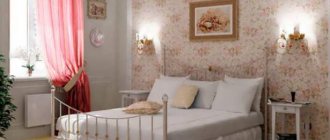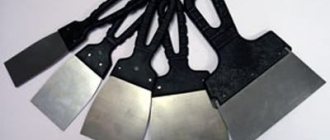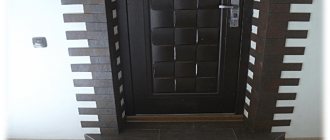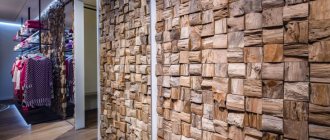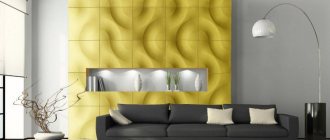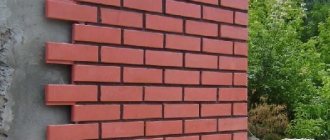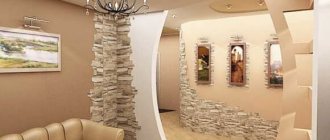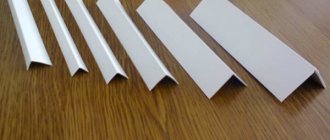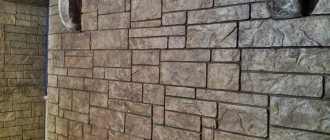Advantages and disadvantages
Advantages of finishing with decorative stone and wallpaper:
- Suitable for any apartment interior;
- Wide selection of materials, rich color palette;
- Uniqueness of style;
- Durability and ease of operation;
- The ability to complete the finishing yourself without the help of professionals;
- Environmentally friendly materials.
Flaws:
- Relatively short service life compared to natural stone; Products made from low-quality raw materials quickly wear out and become unpresentable;
- If you approach the choice of material responsibly, then all of the above disadvantages will remain in the shadows. To extend its service life, the surface of the stone is treated with impregnation or coated with a protective varnish.
Key usage features
Every time we try to integrate some new element into our living space, we hope that it will reveal its potential in any case. However, the opposite situations often happen. In order not to throw ashes on your head about this later, it is better to foresee all the nuances in advance - such a constructive approach to organizing the interior will undoubtedly bear fruit.
Consider the size of the room
Very often people try to overload their already modest square meters with flashy details. Decorating the walls with decorative stone and wallpaper cannot be considered cosmetic changes in the interior: such a combination invariably attracts attention, makes you look at the texture over and over again and note the mood that it brings to the house. And it’s good if there is enough free space so that the entire decorative potential of such a solution can be fully revealed. But otherwise, we get an extremely uncomfortable interior with all the ensuing sad consequences.
Remember:
decorative stone combined with wallpaper in any room requires enough free space to reveal all the beauty of its texture. If the usable area of the room is modest, then you should think about the advisability of using such a combination at all, otherwise the risk of turning the apartment into some kind of cave and losing all the comfort is very high.
Lighting is your secret weapon
We have already mentioned the role of lighting in unlocking the decorative potential of stone texture. You really have at your disposal a significant trump card, the use of which allows you to radically transform the visual appearance of the room and emphasize the successful choice of one or another finishing solution.
If the texture of a decorative stone is already replete with relief and you want to consistently diffuse light across the entire surface of the wall to create a harmonious look, then use front rays, which allow you to somewhat smooth out the relief and remove all unnecessary shadows. This option is again good for small rooms, in which an overly active decorative stone texture on the walls can provoke visual redundancy.
If you are faced with the exact opposite task, then use central lighting with streams of light from above
: this way you can get an amazingly beautiful and even mysterious play of shadows and advantageously emphasize the features of the stone texture of the walls.
The photo shows several options for using the winning combination. We selected options both in the hallway and in the kitchen.
Photo wallpaper + plaster = a good combination
Sometimes there is no room to turn around in the hallway, but if you decorate the wall in a fresh and original way, your guests will completely forget even about this inconvenience. For this, use wallpaper with some interesting image, and on top of it, decorate the walls with decorative stone. Gypsum is very suitable for these purposes, as it adheres perfectly to any type of surface. As a result, you can get a breathtakingly beautiful result that will significantly expand the boundaries of your cramped hallway and allow not only your guests, but also you to feel comfortable in it.
Here are some successful examples with photos where similar wall decoration with decorative stone and wallpaper is made in the hallway - and you can look at it endlessly.
Be smarter - decorate the corners with decorative stone
Our four-legged friends at home have an undisguised love for corners: the way the wallpaper is damaged in these places can be seen in every apartment. However, you may well be smart and give a decisive rebuff to the unruly “hooligans” if you decorate the walls with decorative stone in this “in-demand” place. As a result, the walls will receive a few points in terms of visual perfection, but most importantly, they will remain intact.
However, even if you don’t have pets, nothing prevents you from using such a tool: in combination with wallpaper it looks extremely advantageous, fresh and interesting.
Highlighting the apron and dining area
Here you should be extremely careful: not every decorative material used to imitate stone can be suitable for decorating a work area (apron). The fact is that constant operation in conditions of high humidity and periodic contact with water can seriously reduce the service life of gypsum wall finishing. But they will cope perfectly with all these nuances of imitation porcelain stoneware
,
flexible stone
or
clinker
- they can be safely used to decorate the work area.
The only thing is that for these purposes it is better to use a calmer texture - it is easier to care for, but every housewife knows perfectly well what an apron is and how long it sometimes takes to wash it after intense cooking.
But as a wall decoration for a dining area, gypsum performs well without losing its performance qualities. Take a look at a few photos and see for yourself. We emphasize that wallpaper in the kitchen should also be chosen carefully, giving preference to practical, washable options.
Types of stone
In the design of a hallway with decorative stone, two types of stones are used: artificial and natural.
Decorative rock
Decorative stone is most often used for interior decoration in the corridor. It is heat-resistant, moisture-resistant, easy to maintain and durable with proper use.
In addition, it is an order of magnitude cheaper than natural analogues. The range of decorative stones is very wide.
The color palette and texture are extremely diverse and compare favorably with natural analogues. Therefore, it is easier to choose wallpaper for artificial stone and lay out unique masonry.
A natural stone
It looks much more presentable than its artificial counterpart, as it is part of nature. Naturally, the price for this material will be much higher, but you will be pleased with the quality and durability of the product.
Depending on the style and chosen composition, you can choose different types of stone. Each breed has a unique color, texture and shape. Granite and sandstone are most often used for interior decoration of residential premises.
Natural stone in the hallway requires a large space. Therefore, this type of material will be appropriate only in spacious rooms.
Advantages of artificial material
Before you make your choice, you should find out all the advantages of finishing with artificial stone:
- Relatively low price.
- Light weight, which reduces the load on wall supports.
- There are no special care or cleaning requirements.
- Does not fade under the influence of sunlight.
- Wide selection of models in color, texture and shape.
This type of decorative stone has earned particular popularity among apartment owners and interior decorators due to the ease of repair work.
- Hanger in the hallway: 185 photos of modern ideas for the design and use of hangers
- Paintings for the living room: beautiful and modern trends in the placement of paintings (135 photos and videos)
Buying porcelain tiles: instructions on how to choose, where to buy, which one is better
Features of the combination of stone and wallpaper
The decorative material is universal and goes well with any type of wallpaper.
The hallway is a frequently visited place in the apartment, so the wallpaper must be functional and of high quality.
Finishing the hallway with liquid wallpaper and decorative stone is perfect for these characteristics. But you can use other types of wallpaper.
Paper wallpaper
The cheapest option. You can easily hang wallpaper yourself, without the help of specialists. Also, they lend themselves well to coloring.
Disadvantages: fragility.
Non-woven wallpaper
They have a porous texture. Under such wallpaper you can hide uneven walls without resorting to preliminary plastering.
Advantages: strong and durable in use, easy to paint. Disadvantages: high cost of material.
Glass wallpaper
They go well with artificial stone due to their embossed surface.
Liquid wallpaper
The main advantage is ease of gluing, excellent sound insulation and thermal insulation.
Before applying wallpaper, the walls are carefully leveled and treated with a primer.
Color selection
In most apartments, the corridor has a small area; a beneficial solution would be to visually increase the space. Most often, in the interior design of a corridor or hallway, shades of purple, gray, white or flesh are chosen.
When choosing a stone, preference is given to marble, granite and quartz, and their artificial analogues. Light wallpaper goes well with stone in a dark color palette. An excellent option when the wallpaper is a couple of shades lighter than the stone. It looks harmonious, but not boring.
Cement-based decorative stone
This coating option is particularly durable and resistant to moisture. The surface of walls finished with cement stone is easy to clean without fear of residual contamination. For finishing the hallway, cement elements will be an excellent solution.
In addition, the stores offer the buyer a huge assortment of design ideas.
But when choosing this material, it is worth remembering the negative aspects of stone: heavy weight, difficulties when cutting and polishing building blocks. Before laying the covering, additional strengthening of the walls is required.
Style directions
Art Nouveau style
A combination of decorative white stone with light wallpaper is used. It looks modern, fresh and presentable. Visually enlarges the room.
Eco style
They give preference to slate rocks of natural stone, which are combined with wallpaper in light or natural shades.
Urban style or loft style
Decorative brick-like stone is used in combination with wallpaper in gray shades. It seems as if the hallway is a continuation of the street.
Classic style
Natural types of stone are used: marble or granite in combination with wallpaper in warm and soothing colors. It looks noble and suits any interior style.
Provence style
Use a brown or gray stone in combination with lilac, purple, emerald or beige wallpaper.
Decorative stone in various stylistic directions
Natural materials, wood, stone, are organically integrated into a diverse style. Decorative artificial tiles make it possible to choose an imitation of natural materials at an affordable price. For example, natural polished marble is much more expensive than porcelain tiles.
Decorating balconies with decorative stone Source polinka-by.tam.by
Classicism
This category includes styles: baroque, antique, renaissance, neoclassicism and some others. All styles are united by the desire to recreate a richly decorated, solemn interior with a touch of pathos. Marble, polished granite, aventurine with mica inclusions are decorative companions for such interiors. The stone is mainly used to decorate fireplaces, columns, and wall panels. The main thing is to maintain balanced proportions between all the design elements of the room. Use the slab as a floor covering. Decorative marble-effect tiles are used in bathrooms.
Floor tiles in the living room interior Source 3dplitka.ru Classic interior Source www.etsy.com
See also: Catalog of companies that specialize in finishing materials.
Design solutions
We list the main tricks when decorating a corridor:
- To make the walls of the room look taller and wider, make an uneven edge from stone.
- In order to emphasize the cladding, install lamps and sconces on it.
- To give your hallway a unique style and highlight the design, add decorative elements to the wall. For example, a mirror, a painting or a panel, designed in the same style.
- Create a “living corner” with indoor plants. This will give the room freshness and environmental friendliness.
- Use shelves and hooks to store things.
A little about beauty: what stone wallpapers contain
Stone wallpaper in the interior is a desirable decoration, but what are they? Stone-effect wallpaper is an artificial, thinnest decorative stone that is safe for health from an environmental point of view. Stone wallpaper is made in the form of slabs, approximately 16 mm thick.
Many people prefer to choose stone wallpaper for wall decoration because it is not only cheap, but also easy to apply
Stone wallpaper has a number of advantages:
- They are easy to glue;
- They serve for a long time;
- They are relatively cheap.
Stone wallpaper has a very elegant look, regardless of the color and size of the tile. They look very advantageous in small rooms because they do not reduce the space. Stone wallpaper boasts quality and durability that may not be available in some other types of wallpaper. Wallpaper has good sound and heat insulation.
Separately, it is worth mentioning the production of wallpaper tiles. It can be made independently or in a special production facility. The production of tiles for stone wallpaper is accessible to anyone and does not eat up much of the budget. If desired, established production can be turned into a profitable business.
You can stylishly decorate the interior of your living room by finishing one wall with artificial stone.
The tiles are made from gypsum stone, which then needs to be painted. It is easy to paint; there is a wide range of colors and methods for painting gypsum stone.
Gluing stone wallpaper is very simple. Many people worry about how one tile will fit into another. The whole point is that the size of a particular tile can be adjusted by cutting, sawing, grinding and other methods. Due to their small thickness, the tiles easily adhere to corners, eliminating the need to use corner pieces. To glue the wallpaper to the wall, just use strong glue; you don’t need to take any special tools.
Related article: How to make a door to a pantry: recommendations
Combination of decorative stone and wallpaper
The combination of wallpaper and stone should be natural and harmonious. Therefore, it is not recommended to combine artificial stone in the interior of the hallway with abstract wallpaper.
When choosing a color, create subtle transitions in the color scheme and give preference to wallpaper in calm, neutral tones.
Bright designs look ridiculous and distract attention from the main element - the decorative stone.
Vinyl embossed wallpaper is also not the best option for combining with stone, since both materials are striking here at once. Golden rule: wallpaper should be calm and neutral in relation to the stone, and only emphasize its texture and color.
Where is it used?
It must be said that the scope of application of decorative stone in the interior of premises for various purposes is quite wide. You can place decorative stone, especially in addition to other materials, in many places. Here is just a short list of rooms and premises:
- Hallway.
- Living room.
- Kitchen.
- Bedroom.
- Loggia.
- Retail premises.
- Halls and foyers of office buildings.
Depending on what exactly the buyer/customer likes best, various options for decorating the interior space of the hallway and other rooms with stone can be used:
- As the main finishing material.
- As one of the auxiliary coatings when combining different types of finishes.
In addition, in addition to wall decor, artificial stone has another opportunity for use in the interior of rooms. We are talking about finishing the ceilings, usually partial. It is used as an additional measure to give the room a more finished look. Of course, it is difficult to imagine the ceiling of a room being completely finished using stone finishing. However, if we talk about fragmentary use, then it is quite acceptable.
Attention! Do not forget that different materials must be successfully combined, including color.
Almost everyone knows that stone finishing does not suffer from fungus or mold, unlike some other types of finishing coatings, and is also not afraid of corrosion or mechanical damage. In addition, this material, which can be used as a companion when finishing interior walls and partitions, is also distinguished by the fact that it is able to provide the highest level of environmental safety. This makes it possible to place such material in any living room, since it is absolutely safe for human health: both adults and children.
Stone trim in the form of an arch
A popular option in the interior of a corridor or hallway is to line the passage into the room with stone. The doorway looks original if the stone overlaps the wall in places. The arch can be made in any color and style. Also, the masonry on one side of the entrance looks original.
As you can see, for successful repairs it is not always necessary to resort to the help of professionals. When creating a corridor design with decorative stone, stick to the same style in accordance with the entire apartment. You will definitely succeed!
Tips for installing decorative stone
1. First, you should prepare the walls in the room, namely, clean the surface of any remaining plaster and wallpaper. 2. For repair work you will need household tools; 3. Before starting work, it is necessary to plan the lighting system and organize the electrical wiring. 4. The surface is leveled using putty or plasterboard. Drywall is chosen if LED lighting is planned - the gap between the sheets and the wall allows the devices to be built in.
Experts recommend that you approach this stage with utmost care, because it is easier to lay artificial stone on a flat surface.
5. For installation, use a special adhesive composition, putty solution or “liquid nails”. The most popular option is laying tiles with glue. 6. If necessary, the seams between the elements are filled with mortar.
Photos of examples of hallway decoration with decorative stone and wallpaper
Share with friends:
Do-it-yourself stone wallpaper: what subtleties you should know
You can make stone wallpaper yourself thanks to the appearance of flexible natural stone on the market. Flexible stone is so named because it can take any shape. They can decorate any part of the house, both floor and ceiling. Flexible stone is safe for health and looks extremely aesthetically pleasing in interior decoration.
Making stone wallpaper is not difficult and you can do it yourself
Flexible stone has a number of features:
- It is elastic;
- It is light;
- It can withstand high temperatures;
- Sold in rolls;
- Flexible house sheets can transmit light, which gives them additional design possibilities;
- Flexible stone is durable: its service life is about 40 years.
Related article: When can you glue wallpaper after priming?
To make stone wallpaper, you should take a roll of flexible stone, tools, glue for light-colored ceramics, and a protective coating. The sheets of the roll must be laid so that the pattern is solid.
Decorative stone-look tiles in the bathroom
The use of decorative stone in the bathroom has become popular recently. This is partly due to the popularization of eco-style. Designers are actively using the newfangled trend.
A bathroom lined with decorative stone looks natural.
In such an interior it is pleasant to take water treatments. A bathroom lined with marble and granite slabs acquires additional charm. Such design solutions are suitable for open showers with a drain instead of a tray. Free-standing bathrooms look impressive in an interior with a natural stone texture.
How to use in the interior
I want to share with you a few tips on using decorative stone for interior decoration:
- basic, unifying the entire style of an apartment or house, lining window and door openings. Here you can choose imitation brick, which fits perfectly into any style;
- An excellent backdrop for a large TV in the living room will be decorating part of the wall. If the room has a fireplace, then it can be lined with this material. This is a win-win option that carries a powerful stylistic load;
- Flemish brick imitation is suitable for decorating any room, allowing you to create a special atmosphere in the room;
- material with a rocky surface goes well with various pieces of decoration, plaster, wallpaper and painted walls;
- The kitchen apron can be lined with stone, creating a continuous space and a very stylish interior. In this case, it must be varnished to facilitate daily cleaning and emphasize the structure of the selected material.
Stone in the interior of a balcony and loggia
The stone decor fits organically into the design of the balcony loggia. From a practical point of view, it is suitable for small areas. The walls do not get dirty and are easy to clean.
The slabs are not susceptible to changes in humidity.
To visually expand and transform the space, the same techniques are used as for hallways.
Relaxation areas and a mini-office are equipped on the loggias. If the area allows, you can make a dining area. In the case where a balcony or loggia is combined with a children's room, it is advisable to equip there a play area and a place for activities. The decor allows you to beautifully decorate a small space.
The panoramic view that opens from the loggia goes perfectly with the texture of the stonework.
Frequently used design solutions:
- framing an opening, passage;
- “torn” masonry;
- decor of one of the walls;
- decoration of structural elements with decorative stone.
A small room decorated with decorative stone with different textures, for example, brick and cobblestone, looks interesting.
Stylish wallpaper with a stone pattern: arguments in favor of imitation
Stone-effect wallpaper has a number of advantages over decorating walls with decorative stone.
You can make a room beautiful and original with the help of stone wallpaper, which will always fit harmoniously into the interior of the room
The main advantages of wallpaper imitating stone include:
- Low cost of material, possibility of self-assembly and gluing;
- Using stone wallpaper, you can create any patterns and designs;
- Changing the wallpaper or removing it altogether does not require much effort;
- Stone-effect wallpaper does not require the purchase of borders, moldings, etc., the wallpaper does not form joints and looks harmonious on any surface;
- Thanks to the large assortment, you can realize any design idea.
Do not be afraid of the unusual appearance of the interior that will appear along with the stone wallpaper.
Wallpaper “imitation stone” and its nuances
The wallpaper imitates real stonework through a special color. Sometimes wallpaper looks so realistic that it is difficult to tell with the naked eye whether it is a real stone or not. Stone-effect wallpaper should be selected based on the room where it will be located.
Modern stone wallpaper will not only decorate the living room, but will also surprise you with its realistic appearance
For example:
- In the bathroom there is a possibility of water getting on the wallpaper;
- In the kitchen, wallpaper can become contaminated with grease or steam;
- In the hallway, stone-look wallpaper can be damaged by accidental contact with shoes, etc.
When choosing waterproof stone wallpaper, you need to remember that they are short-lived and quickly lose their freshness and beauty. Stone-effect wallpaper is well suited for decorating living rooms, bedrooms, offices or dining rooms (not kitchens). They should be where there is plenty of air and some sunlight. In the kitchen and bathroom, you should use only waterproof wallpaper that can withstand even the most dramatic temperature changes. Acrylic or vinyl wallpaper with a stone look are suitable for this purpose. You can also use non-woven wallpaper, because they are stronger and more resistant than many.
Types of artificial stone for decorating walls inside an apartment
This type of stone creates the appearance of natural stone, which is why designers often use it. It is cheaper and easier to mount on the surface.
Concrete
This is a budget-friendly and simple finishing method that can be easily done with your own hands. The weight is light, which allows you to quickly finish the job. It can be made using sand, strength additives, dyes, and plasticizers.
This is a universal option that can be easily mounted on any surface.
Advice! Additives or plasticizers must be used - they increase structural strength and quality characteristics.
Acrylic
Decorating with acrylic stone has its advantages:
- light weight;
- no toxins;
- ease of installation - can be glued with special compounds;
- is not exposed to moisture, temperature, or mechanical damage.
This is a great option for any room.
Ceramic
This stone consists of red clay and granite chips, which are mixed and pressed under high temperatures. Thus, the finishing surface becomes shiny and glossy. This is a minus - the product can be easily scratched, it is practically not subject to restoration.
Disadvantages include heavy weight and difficulty of installation.
Most often it is used to decorate the walls of a building from the outside, rarely from the inside. Second option: stone-look ceramic tiles. This is a common material that can be purchased at any hardware store.
Plaster
It is made in this way: a liquid gypsum solution is poured into shaped molds and removed after complete drying. It is easy to work with and cut, its weight is almost 2 times less compared to concrete. Beautiful appearance and low cost are two factors for which gypsum stone has become a leader in the construction market.
Gypsum stone for interior decoration of an apartment is an excellent solution if it needs to be mounted on a plasterboard wall.
Quartz
This material is considered half artificial - the finished product contains almost 90% natural mineral. An ethereal synthetic resin acts as a binding base. Due to its excellent performance characteristics, quartz is used in the manufacture of countertops and sanitary ware.
Its cost is higher than that of acrylic analogues.
Natural stone finishing
Supporters of natural materials can purchase plates made of natural stone for finishing. Before purchasing, consult with specialists; the material is very expensive, and it will not be appropriate in every room.
Typically used for the manufacture of finishing slabs:
- marble;
- granite;
- sandstone;
- limestone.
It is difficult to cover all walls with such material not only because of the price. The plates are very heavy, the structure on which they are attached must be strong enough to support this weight. In a small room, thick slabs will take up some of the space and will seem out of place.
Stone is a cold material; it is good to hold balls or special ceremonies in halls with such cladding. Not everyone will like living in such an environment. The effect of slab cladding is especially difficult in the bedroom, where a person should feel softness and warmth in everything. Decorating the walls with decorative gypsum stone will add warmth to any room.
